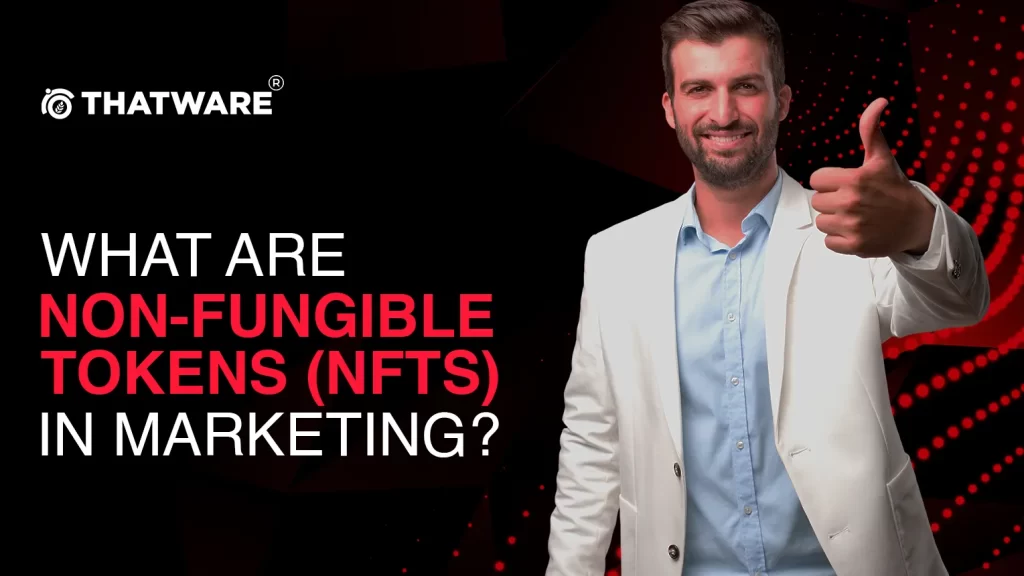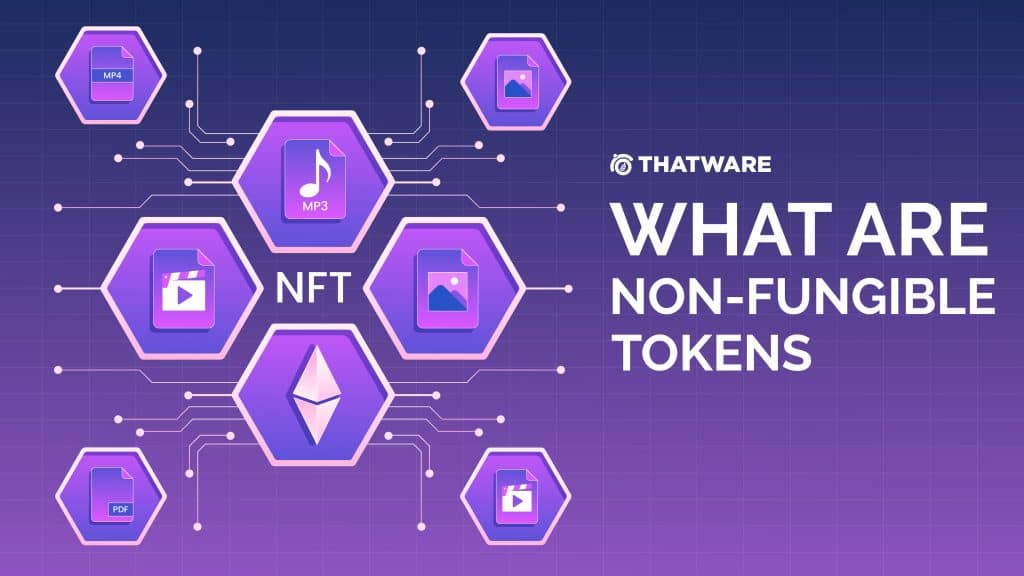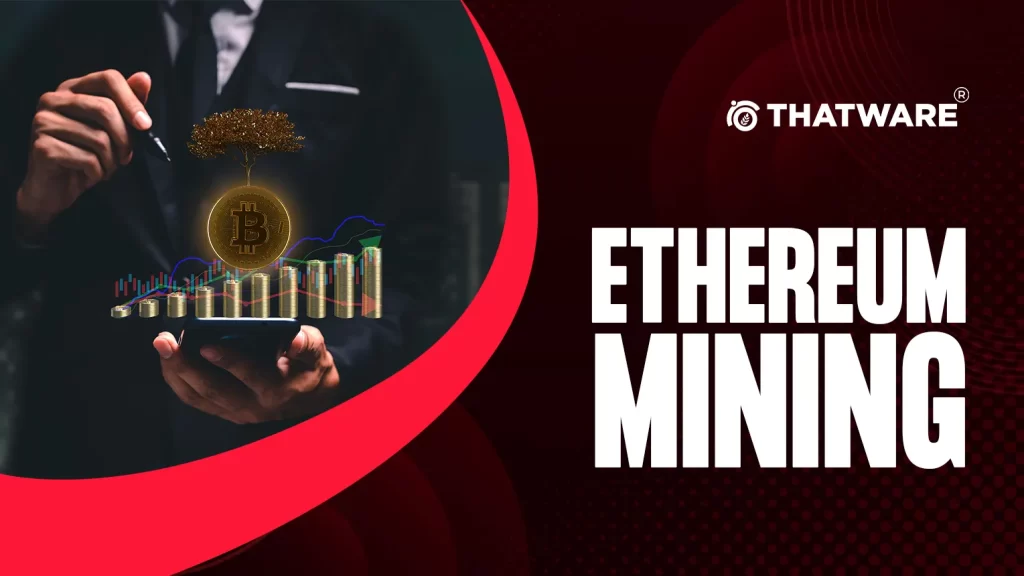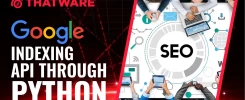Get a Customized Website SEO Audit and Online Marketing Strategy and Action Plan
Every week, it appears that a new marketing trend emerges. NFTs are the newest craze. But what exactly are Non-Fungible Tokens (NFTs), and what do they have to do with marketing? We’ll address all of your questions regarding non-fungible tokens, so you can appear knowledgeable and up to date at your next marketing meeting. We’ll also talk about if an NFT is a smart marketing strategy for your company.
NFTs, digital assets stored on blockchain, offer unmatched uniqueness and ownership, driving unprecedented opportunities for marketers. With their creative burst, NFTs hold the potential to create immersive and interactive marketing campaigns.

Here’s a captivating dive into the world of NFTs in marketing:
- Unique Digital Assets: NFTs are one-of-a-kind, verifiable digital assets. Marketers can tokenize content, such as art, music, videos, or even virtual real estate, making it exclusive.
- Immersive Storytelling: Brands use NFTs to craft immersive narratives. These tokens enable interactive storytelling, with each token unveiling a part of the story, ensuring audience engagement.
- Brand Collaboration: NFTs allow for partnerships with artists and influencers, offering a fresh dimension to marketing collaborations. This collaboration can be an engaging element of NFT marketing campaigns.
- Reward Systems: Marketers can use NFTs as rewards for loyal customers. These digital collectibles can be used to incentivize customer loyalty and participation in promotional activities.
- Ownership and Value: NFTs grant ownership to the buyer, and their value can appreciate over time, creating a potential for secondary market sales.
- Transparency and Authenticity: The blockchain technology underlying NFTs ensures transparency and authenticity. Buyers can verify the originality and provenance of the NFT.
- Tokenized Experiences: NFTs can offer exclusive experiences like backstage passes, virtual meet and greets, or personalized content, making consumers feel valued and engaged.
Non-Fungible Tokens (NFTs) are an exciting avenue for marketers to explore. Their uniqueness, engagement potential, and capacity for storytelling make them a powerful tool in the modern marketer’s toolkit. As the world of marketing continues to evolve, NFTs offer a unique way to connect with consumers in the digital frontier.
So, are you ready to dive into the world of NFT marketing and unlock new dimensions of creativity and engagement?
WHAT EXACTLY ARE NFTS?
Non-Fungible Tokens (NFTs) have taken the digital world by storm. But let’s dig deeper into the fascinating realm of NFTs.
At its core, NFT stands for “non-fungible token.” While that might sound like a mouthful, it’s worth exploring what this term truly means.
In technical jargon, an NFT is a unique digital asset, traded using cryptocurrencies like Bitcoin, and hosted on the Ethereum blockchain. However, that definition doesn’t paint the whole picture.
Picture NFTs as the digital equivalent of collector’s items, but with a twist. These digital gems can encompass a wide range of media, from art and music to videos and virtual real estate. The possibilities are as vast as the digital universe itself.
Now, here’s the catch. Owning an NFT doesn’t stop someone else from downloading the same digital asset. It might seem counterintuitive, but it’s not so different from owning a famous artwork. If you have the original Picasso, others can still buy prints of the same masterpiece and hang them on their walls.
The term “non-fungible” is the key here. It means that each NFT is truly one-of-a-kind and irreplaceable. Think of it this way: if someone borrows your dog, they can’t just swap it for another dog or any other pet. On the other hand, a dollar is fungible because you can easily exchange it for another dollar.
- NFTs are essentially a digital certificate of ownership. When you own an NFT, you hold a unique, verifiable claim to a digital work. It’s like having a certificate of authenticity for a famous painting or a deed for a piece of real estate.
- These digital assets are not only about ownership but also about the concept of provenance. The blockchain technology underpinning NFTs provides an unbreakable chain of custody. This ensures the originality and history of the NFT, enhancing its value.
- While digital art dominates the NFT landscape, the concept extends far beyond. Musicians release exclusive tracks, filmmakers premiere limited-edition scenes, and even virtual real estate is bought and sold as NFTs.
- The allure of NFTs isn’t just about ownership; it’s about community and engagement. Creators, artists, and collectors come together on NFT platforms to explore a universe where creativity knows no bounds. These digital marketplaces are vibrant, dynamic ecosystems, where creators can find their audience, and collectors can discover unique treasures.
- Let’s take a step into the future. Imagine a world where you attend a virtual concert and own an NFT that grants you backstage access or an exclusive virtual meet-and-greet with the artist. The possibilities are quite limitless!
Now, you may wonder about the environmental impact of NFTs. While blockchain technology does consume energy, the industry is actively working to address this concern, with many projects exploring eco-friendly blockchain alternatives.
HOW DO NFTs WORK?
NFTs, the new-age digital collectibles, are tightly woven into the Ethereum blockchain’s fabric. Ethereum, akin to Bitcoin, is a cryptocurrency, but its true power lies in its smart contracts, enabling NFT creation and management.
At the most basic level, NFTs are a component of the Ethereum blockchain. Ethereum is a cryptocurrency similar to bitcoin in that it stores information about non-fungible tokens. The NFT is immutable on the blockchain.
The easiest way to conceive about them is to consider them as something to collect, similar to fine art, except that the collector’s goods are anything digital. (However, they can still be considered art.)
Non-fungible tokens are a (very profitable) way for digital artists to sell their work online. However, as we’ll see later in this essay, non-fungible tokens have at least one disadvantage.
Ø Immutable and Indelible
One of the defining characteristics of NFTs is their immutability. Once minted on the blockchain, they become indelible, forever etched in the digital ledger.
Ø The Art of Collecting Digital Dreams
Imagine NFTs as a gallery of digital collectibles. Unlike conventional art, the canvases are digital, yet they still hold the allure of art.
Ø Digital Art’s Profitable Avenue
NFTs have opened lucrative avenues for digital artists. They can showcase and sell their creations with ease, circumventing the need for traditional art markets.
The Journey of an NFT
- Creation: Artists create digital artworks and tokenize them, converting them into NFTs using Ethereum-based platforms.
- Minting: These NFTs are then minted, a process that records the unique data of the artwork on the blockchain.
- Ownership: When someone buys an NFT, they gain ownership of a token representing the digital artwork. This ownership is verifiable on the blockchain.
- Transfers and Provenance: NFTs can change hands, and their entire transaction history is transparent, ensuring provenance.
- Secondary Markets: NFT owners can resell their tokens in secondary markets, potentially at higher prices.
NFTs’ Dark Cloud: Environmental Concerns
While NFTs have revolutionized the art world, they have garnered criticism for their environmental impact. Ethereum’s energy-intensive mining process raises sustainability questions.
Blockchain and Sustainability: The Struggle
Ethereum’s proof-of-work consensus mechanism, similar to Bitcoin’s, consumes significant energy. This has led to debates about the environmental footprint of NFTs.
Ethereum’s Shift Towards Sustainability
Ethereum is transitioning to a proof-of-stake mechanism, Ethereum 2.0, aiming to significantly reduce its energy consumption. The NFT community welcomes this move.
The Bright Side of NFTs
Amid the environmental concerns, NFTs offer several advantages:
- Accessibility: NFTs democratize the art world, allowing artists worldwide to reach a global audience without middlemen.
- Provenance and Authenticity: The blockchain ensures that NFTs’ ownership and history are transparent, combating art forgery.
- Monetization for Creators: Digital creators can monetize their work more easily, creating a sustainable income source.
- Collectors’ Dream: Collectors gain access to a vast world of digital art, establishing unique and valuable collections.
- Interactivity: Some NFTs come with bonus features, allowing collectors to participate in the development of the art.
The NFT Revolution Continues
NFTs have redefined the digital art landscape. They provide a platform for artists to showcase their work, offer collectors a new realm to explore, and reshape the way we perceive ownership. However, environmental concerns persist, and the shift to Ethereum 2.0 is a step toward mitigating them.
As NFTs continue to evolve, their future remains uncertain but promising. They are not just about art, but about transforming the digital realm. It’s a journey where creativity meets technology, and the canvas is the blockchain, where every stroke is a unique token of the digital age.
THE ENVIRONMENT AND NFTS
An additional aspect about NFTs that you may not be mindful of is that they are environmentally hazardous. You might be asking what the connection is between digital art and the physical world.
NFTs and Their Surprising Environmental Footprint
Non-fungible tokens (NFTs), often celebrated for their digital creativity, carry an unexpected environmental burden. Explore this connection.
The Environmental Impact of Digital Art
NFTs are linked to cryptocurrencies that generate millions of tons of CO2 emissions, significantly contributing to global warming.
The Overlooked Mining of Bitcoin
Bitcoin’s energy-intensive “mining” process is often neglected. However, it plays a vital role in the environmental equation.
Ethereum: The Energy Hungry Giant
Ethereum, the blockchain most NFTs are built on, consumes a staggering 26.5 terawatt-hours yearly, akin to Ireland’s annual energy use.
A Deeper Dive into NFTs’ Environmental Controversy
Explore the reasons behind NFTs being scrutinized for their perceived harm to the environment.
Blockchain’s Energy Demand
The infrastructure behind NFTs, blockchain technology, is energy-hungry. Discover how it affects the natural world.
Mining Explained
Understand the energy-intensive process of mining that powers the cryptocurrency market and affects NFTs indirectly.
The E-Waste Problem
Discover the concerning rise in electronic waste as NFTs and their supporting technologies drive hardware demand.
Hypothetical Solutions
Explore potential strategies to mitigate NFTs’ environmental impact and find a balance between creativity and sustainability.
Blockchain Innovations
Learn about emerging blockchain technologies that promise a more eco-friendly approach to NFTs and digital art.
The Role of Artists and Collectors
Discover how artists and collectors influence the eco-friendliness of the NFT market through their choices and collaborations.
The Call for Change
Unveil the efforts and initiatives within the NFT community to address environmental concerns and find a middle ground.
NFTs and Conservation
Explore how NFTs can potentially be a force for environmental conservation, supporting critical causes through tokenization.
THE QUEST for ECO-FRIENDLY NFTs – THE PROMISE of RENEWABLE MINING ENERGY
In the fast-paced world of cryptocurrencies and NFTs, environmental sustainability has become a pressing concern. The digital age, characterized by remarkable creativity and innovation, must now reconcile with its environmental footprint.
A major player in this dilemma is the energy-intensive process of mining, which powers the blockchain technologies underpinning NFTs. While renewable energy holds the potential to alleviate these concerns, the road to an eco-conscious NFT ecosystem is far from clear-cut.
The Energy Demands of Cryptocurrencies and NFTs
Cryptocurrencies like Bitcoin and Ethereum, on which many NFTs are built, rely on a system known as proof-of-work. This method involves solving complex mathematical puzzles to verify transactions and add new blocks to the blockchain. However, this process demands an enormous amount of computational power, resulting in substantial energy consumption.
The environmental implications are substantial. Mining cryptocurrencies releases a significant amount of carbon dioxide into the atmosphere, contributing to global warming. In this context, non-fungible tokens have come under scrutiny for their role in the carbon footprint of the digital age.
Renewable Energy: A Glimmer of Hope
The hope for a more sustainable future lies in the adoption of renewable energy sources for cryptocurrency mining. These sources, such as solar, wind, and hydroelectric power, are known for their lower environmental impact. They hold the promise of mitigating the negative effects of energy-intensive blockchain technologies.
Solar Power: A Sunlit Path Forward
Solar energy, harnessed from the sun’s rays, offers a particularly eco-friendly alternative. Small or big solar power plants turn sunlight into electricity, offering a sustainable and clean energy resource. Several cryptocurrency mining facilities around the world have begun to tap into this abundant resource.
Solar-powered mining farms can be located in sunny regions, where sunlight is abundant. These farms aim to reduce the carbon footprint associated with traditional mining operations. The use of solar energy in cryptocurrency mining represents a significant step towards greener NFTs.
Wind Energy: Riding the Breeze of Change
Wind energy is another renewable source with the potential to revolutionize the energy landscape of cryptocurrency mining. Wind turbines create electricity by harnessing the power of the breeze or air. They are often strategically placed in areas with consistent and strong winds, making them a dependable source of renewable energy.
Cryptocurrency mining facilities in windy regions are beginning to integrate wind energy into their operations. By doing so, they reduce their environmental impact and contribute to the growth of sustainable energy solutions.
Hydroelectric Power: The Flow of Green Energy
Hydropower, generated from the movement of water, is a proven and reliable source of renewable energy. Hydroelectric dams capture the kinetic energy of flowing water, converting it into electricity. This energy source has the potential to support cryptocurrency mining operations with a significantly lower carbon footprint.
Hydropower is especially beneficial in regions with abundant water resources, as it ensures a consistent and eco-friendly energy supply. Several forward-thinking mining farms have recognized the potential of this renewable source and are making the switch to hydroelectric power.
Challenges on the Path to Renewable Energy Adoption
While renewable energy sources hold immense promise for greening the cryptocurrency and NFT industry, several challenges need to be addressed:
- Cost and Infrastructure: Transitioning to renewable energy sources requires significant investments in infrastructure, including solar panels, wind turbines, and hydropower facilities. This initial cost can be a barrier to entry for many mining operations.
- Geographical Limitations: The effectiveness of renewable energy sources depends on geographical factors. Solar power is more efficient in sunny regions, while wind and hydropower are location-dependent. This can limit the feasibility of renewable energy adoption in certain areas.
- Intermittency: Renewable energy sources, such as wind and solar, are intermittent, meaning they depend on weather conditions. This can lead to fluctuations in mining operations, which require consistent power.
- Energy Storage: To ensure continuous mining operations, energy storage solutions are needed to store excess energy generated during favourable conditions. Batteries and other storage technologies are still evolving.
- Regulatory and Policy Challenges: The transition to renewable energy may be influenced by regulatory and policy frameworks. Governments play a crucial role in incentivizing and facilitating this shift.
The Urgency of a Concrete Plan
The adoption of renewable energy in cryptocurrency mining is not just an option but a necessity. With the growing popularity of NFTs and cryptocurrencies, the energy demands of these technologies are skyrocketing. The urgency to develop a concrete plan for eco-friendly NFTs cannot be overstated.
While renewable energy sources hold the promise of a greener future, the lack of a structured strategy raises concerns about the sustainability of NFTs. Without clear guidelines and incentives for mining operations to transition to renewable sources, the environmental impact of NFTs remains a contentious issue.
The Role of the NFT Community
The NFT community, including artists, collectors, and platforms, can play a pivotal role in shaping the industry’s environmental trajectory. Collaborations and initiatives that prioritize sustainability are vital. Artists can choose eco-conscious platforms for minting their NFTs, collectors can support green initiatives, and platforms can encourage the use of renewable energy for mining.
The Need for Collaboration
Realizing the promise of renewable energy in the NFT space requires collaboration among stakeholders, including governments, mining operations, and the crypto community. Incentives, subsidies, and regulations can be implemented to encourage the adoption of renewable energy.
The Imperative for a Sustainable NFT Ecosystem
The future of NFTs hinges on the industry’s ability to embrace renewable energy solutions. While the promise of solar, wind, and hydroelectric power offers hope, concrete plans and collective action are essential. The urgency to address the environmental impact of NFTs underscores the imperative for an eco-conscious NFT ecosystem.
NFTs have the potential to be not only creative and innovative but also environmentally responsible. It is in the hands of the crypto community, artists, collectors, and policymakers to forge a path toward a sustainable NFT future. In doing so, they can ensure that the digital age leaves a positive mark on the environment.
NAVIGATING THE NEW NFT WAVE in MARKETING: TRENDS, VIABILITY 7 THE CALL for EXPERTISE
In the ever-evolving realm of marketing, Non-Fungible Tokens (NFTs) have emerged as the latest trend, capturing attention with their unique blend of creativity and blockchain technology. However, while NFTs are currently the hottest topic in marketing, their viability as a marketing approach varies significantly across different businesses.
This content delves into the world of NFTs in marketing, exploring their potential, their limitations, and the importance of expert guidance.
Non-Fungible Tokens (NFTs) are digital assets that represent ownership of unique items or content on the blockchain. These tokens have gained immense popularity for their ability to authenticate ownership and provenance of digital assets. From digital art to collectibles, NFTs have opened up new horizons for creators and collectors alike.

NFTs in Marketing: The Hottest Trend
NFTs have rapidly taken the marketing world by storm. They offer a novel way for brands to engage with their audience, generate social media buzz, and even create viral news stories. NFT marketing has found its sweet spot with businesses that boast a strong presence on social media and are closely tied to popular culture.
The Viability of NFT Marketing Approaches
The application of NFTs in marketing is not one-size-fits-all. The viability of NFT marketing strategies varies based on the nature of the business, its audience, and its overall marketing goals. Let’s explore the key factors influencing the feasibility of NFT marketing.
1. Brand Relevance and Presence
For businesses with a strong social media presence and close ties to pop culture, NFTs can be a viable marketing strategy. They can leverage their existing following to promote NFT sales, creating a buzz that extends their reach.
2. Target Audience
Understanding your target audience is crucial. NFT marketing resonates more with tech-savvy and crypto-curious consumers. It’s essential to assess whether your audience is likely to engage with NFTs.
3. Content Authenticity
NFTs thrive on the concept of ownership and authenticity. Content or products that can be easily tokenized and authenticated hold more promise in NFT marketing.
4. Creative Engagement
NFTs can be a fun way to engage your audience creatively. Businesses with imaginative and interactive NFT concepts are more likely to succeed in this space.
The Potential and Limitations of NFT Marketing
NFTs offer exciting potential for marketing innovation. However, it’s important to recognize the limitations and challenges that come with this trend.
- The Hype Factor: The current buzz around NFTs may not be sustainable. Like any other trend, the excitement can fade, leaving brands with assets that may not hold their initial value.
- Exclusive Ownership: NFTs are about exclusive ownership, which might not align with all marketing strategies. Businesses that rely on mass marketing might find NFTs less suitable.
- Niche Audience: NFTs have a niche following. Marketing with NFTs might not yield the desired results if your audience doesn’t resonate with this technology.
- Risk and Speculation: The NFT market can be volatile and speculative. It’s important to assess the financial risks before venturing into NFT marketing.
Expert Guidance – The Key to Success
While NFTs present exciting opportunities, navigating this complex landscape requires expertise. That’s where professional guidance becomes invaluable.
Why Seek Expertise?
Navigating NFT marketing demands a deep understanding of blockchain technology, market dynamics, and the rapidly evolving trends. Expert guidance can help businesses harness the full potential of NFTs while minimizing risks.
What Can Experts Offer?
- Strategy Development: NFT experts can tailor marketing strategies to your business, ensuring alignment with your goals and audience.
- Content Creation: They can help conceptualize and create NFT content that’s engaging, unique, and in line with your brand.
- Technical Know-How: Experts understand the technical intricacies of blockchain and NFTs, ensuring a smooth implementation.
- Market Insights: They keep a finger on the pulse of the NFT market, providing real-time insights to inform your marketing decisions.
The Road Ahead: NFT Marketing with ThatWare
The world of NFTs in marketing is dynamic and evolving. To explore innovative ideas and harness the potential of NFTs, it’s crucial to have the right guidance. ThatWare offers expert consultation to help businesses navigate the NFT landscape.
HOW AN SEO SERVICE AGENCY CAN PROPEL YOUR NFT MARKETING SUCCESS?
In the dynamic realm of NFT marketing, achieving visibility and engagement is paramount. Non-Fungible Tokens (NFTs) have gained immense traction, creating new opportunities for artists, creators, and brands.
However, standing out in this competitive landscape requires a comprehensive strategy that encompasses Search Engine Optimization (SEO). Now, we shall deeply explore, how an SEO service agency can be your most potent ally in unlocking the full potential of NFT marketing.
Understanding NFT Marketing: A Digital Revolution
Before delving into the role of SEO service agencies in NFT marketing, let’s establish a foundational understanding of NFTs and their impact on marketing.
The NFT Marketing Challenge: Rising Above the Noise
With the surge in NFTs, the competition for visibility and audience engagement has become intense. Every artist, collector, and brand wants to make a mark in this space. This is where the role of an SEO service agency comes into play.
The Crucial Role of SEO in NFT Marketing
Search Engine Optimization is the practice of optimizing online content to rank higher in search engine results. While it’s often associated with traditional websites, its significance in NFT marketing is undeniable. Here’s how an SEO service agency can assist in this digital revolution:
NFT Marketplace Optimization
NFTs are often listed on various marketplaces. An SEO agency can optimize your listings with relevant keywords and metadata, making them more discoverable when potential buyers search for NFTs in your niche.
Content Creation and Optimization
Creating engaging and SEO-friendly content is key to NFT marketing success. SEO experts can help craft content that showcases your NFTs and ranks well in search engine results, attracting organic traffic.
Keyword Research
Understanding the keywords potential buyers use when searching for NFTs is crucial. SEO agencies conduct in-depth keyword research to ensure your listings are aligned with what your target audience is looking for.
On-Page SEO.
Technical aspects like on-page SEO, including meta tags, image optimization, and structured data, are handled by SEO experts. These elements enhance the visibility of your NFTs on search engines.
Off-Page SEO and Link Building.
Off-page SEO, such as building backlinks and increasing your online presence, can elevate the authority and credibility of your NFT brand. SEO agencies excel in building these critical connections.
Data Analytics and Performance Tracking
SEO agencies utilize analytics tools to track the performance of your NFT marketing efforts. This data-driven approach helps refine your strategy for optimal results.
The Power of Niche Expertise
NFT marketing is not a one-size-fits-all endeavour. Each niche within the NFT space demands a tailored approach. Whether you’re a digital artist, a musician, a gaming company, or a brand looking to tokenize assets, an SEO agency with niche expertise can make a substantial difference.
1. Art and Collectibles
For artists and collectors, SEO agencies can focus on optimizing content around the art, its creator, and the stories behind the NFTs. This approach helps create a unique and engaging narrative.
2. Music and Entertainment
In the music and entertainment industry, SEO experts can emphasize the connection between the NFT and exclusive content, such as concert tickets or backstage access. This strategy enhances the appeal of the NFT.
3. Gaming and Virtual Real Estate
Gaming companies and virtual real estate developers can benefit from SEO agencies that understand the gaming community and create content around the in-game experiences offered by NFTs.
4. Brand and Marketing Collabs
Brands collaborating with artists and creators can leverage SEO to tell compelling stories about their partnerships, making their NFTs more enticing to potential buyers.

THE FUTURE of NFT MARKETING with SEO
As NFT marketing continues to evolve, the synergy between SEO and NFTs is poised to grow stronger. SEO service agencies will play a pivotal role in helping artists, collectors, and brands navigate this burgeoning landscape, ensuring their NFTs are not lost in the digital crowd.
SEO—Your Bridge to NFT Marketing Success
In the fast-paced world of NFTs, standing out is no small feat. With the power of SEO, your NFTs can rise to prominence, attract the right audience, and tell a compelling story. The partnership between NFTs and SEO is a dynamic force shaping the future of digital art, collectibles, and marketing.
To unlock the full potential of your NFTs, consider enlisting the expertise of an SEO service agency that understands the intricacies of your niche. With SEO as your ally, your NFT journey can be as unique and captivating as the digital assets you create.
WHY CHOOSE ThatWare?
ThatWare combines expertise in digital marketing, blockchain technology, and NFTs to provide a holistic approach. We offer personalized strategies, creative content creation, and a deep understanding of market trends.
NFT MARKETING — A CREATIVE FRONTIER with EXPERT NAVIGATION
NFTs have undoubtedly introduced a creative and innovative dimension to marketing. However, their viability varies across businesses. Success in NFT marketing demands a careful assessment of brand relevance, audience, and content authenticity.
Furthermore, the NFT landscape can be unpredictable, making expert guidance a valuable asset. Professional expertise can help businesses develop strategies, create captivating content, and stay informed about market trends.
END NOTE:
In the NFT marketing landscape, SEO is the beacon guiding your success. As NFTs flourish, visibility and engagement are paramount. In this dynamic realm, SEO empowers your NFTs to stand out.
The digital revolution brought by NFTs has transformed creator-brand-audience interactions. SEO is an indispensable tool for achieving the visibility and engagement that can set your NFTs apart.
SEO is the force behind the scenes, architecting a framework that enhances your discoverability, engagement, and ultimate success. SEO experts craft strategies that cater to your unique niche.
Meticulous keyword research, on-page SEO, and audience understanding optimize your NFT listings, making them easy to find. Your NFT’s digital journey becomes more engaging and memorable.
SEO service agencies specialize in off-page SEO and link building, expanding your digital footprint and amplifying your presence. This strengthens the authority and credibility of your NFT brand.
In the ever-evolving NFT space, SEO agencies are pivotal in tracking your NFT marketing performance. They utilize analytics tools to measure the impact of your strategies. SEO’s data-driven nature ensures that your NFT marketing is well-informed and dynamic.
Collaborating with an SEO agency that specializes in art and collectibles, digital artists achieved remarkable success. Through meticulous keyword research, optimized listings, SEO-friendly content, and a strategic backlink approach, their NFTs rose to prominence. Their stories and creativity took centre stage, captivating a growing base of art enthusiasts and collectors.
The future of NFT marketing holds endless possibilities. The synergy between SEO and NFTs is poised to become even more potent. SEO service agencies will continue to be the guiding force, helping creators and brands navigate this ever-evolving landscape.
The partnership between NFTs and SEO is more than just a technical alliance; it’s a dynamic force shaping the future of digital art, collectibles, and marketing. Your NFT journey can be as unique and captivating as the digital assets you create, and SEO is your steadfast companion on this exhilarating digital adventure. With SEO as your ally, the potential for NFT marketing success is boundless, and your NFTs can shine brightly in the vast digital cosmos.


